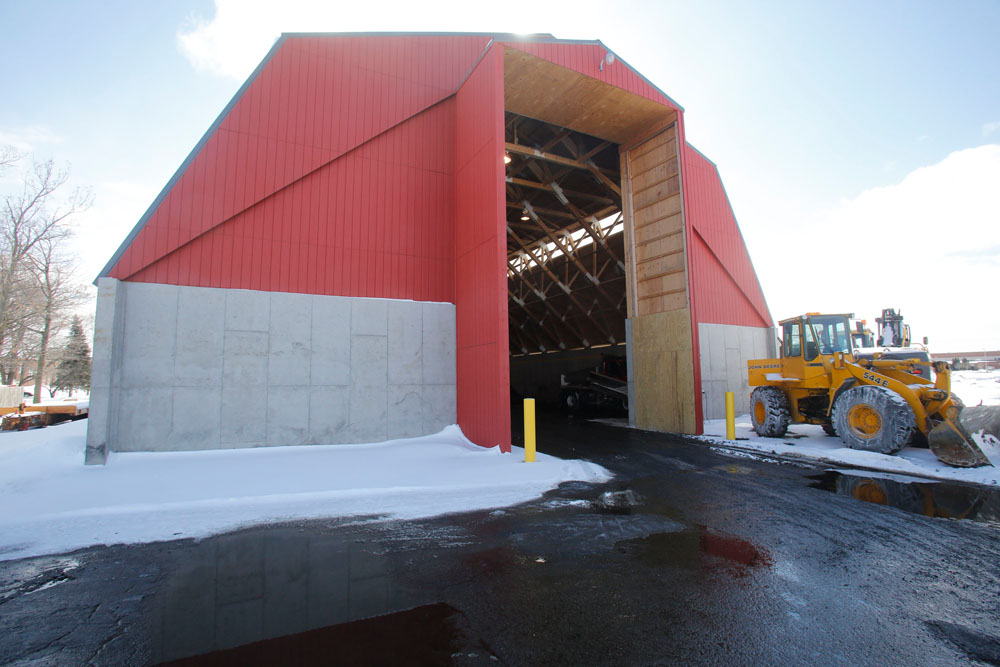Highway crews struggle to handle winter

The winter of 2013/2014 has been a brutal one for people, animals and especially local highway crews that have barely been able to catch their breath between plowing and salting runs.
“Winter is expensive,” says Riga Highway Superintendent David Smith, “I vote to cancel it next year.”
This winter has been a baptism by fire for Smith, who is in his first year at the helm of the Riga Highway Department. Smith says Riga uses about 2,000 tons over the course of a normal winter.
He says Riga is doing OK with their supply of salt. “We used up all our stored allotment,” he says. Riga received 600 tons of salt five weeks ago and another 200 tons three weeks ago. “We will be fine for the winter and are hoping we have no more major snow or ice storms,” he adds.
“We’ve started into the extra 600 tons,” Smith told the Suburban News and Hamlin-Clarkson Herald February 28. The final week of February was another difficult one for highway crews, as daily accumulations of about two inches of snow meant plows had to be out everyday.
The small accumulations day after day are more difficult than one main snowfall, Ogden Highway Superintendent David Widger told Ogden Town Board members during his report at their regular meeting February 25.
“I’m hoping it doesn’t snow all of March,” he said. “Two inches (of snowfall) a day costs money,” Widger explained, as those amounts of snow make driving conditions slick and roads need to be treated.
When asked about remaining supplies of salt, Widger responded, “We’ve got it, and we’ve got enough.”
He tells the Suburban News and Hamlin-Clarkson Herald that local highway departments compile a commitment letter to the state in March or April for the following winter’s salt. Once municipalities receive 120 percent of their contracted amount, the price starts to climb.
Widger told Ogden Town Board members that Ogden has reached about 100 percent on their salt, but some towns and villages are at 150 to 170 percent.
“It can cost an arm and a leg to buy salt (at that point),” Widger says because at higher percentages past the contracted amount, there is no set price.
Harry Donahue is the Department of Public Works Superintendent in the Village of Brockport. He began working there in 1983 and says this has been the coldest winter since the early 1990s.
“It’s been a good old fashioned winter,” Donahue says. The village typically uses about 600 tons of salt each winter season and so far this year has used over 500 tons.
“We will be in good shape,” Donahue says and explains that the village – which has fewer lane miles to plow than area towns – can manage their salt usage.
“If there’s a heavy snow, we don’t typically salt, we just plow,” he says, and agrees with town superintendents that the smaller accumulations of snow, day after day are more difficult to deal with and use up more resources than one, large snowstorm.
He says the village has a salt barn which it shares with the Brockport Central School District and which can hold almost a whole season’s worth of salt.
“In mid-January we stocked up,” Donahue says. The barn was over half-full at the end of February.
“That should take us through the end of the season,” Donahue says.
The Town of Parma has a new salt shed which it shares with the Village of Hilton and the Hilton Central School District, and Highway Superintendent Brian Speer says, “Things started out swimmingly, I thought we would be all set.” But now the town is 20 percent over their contract for salt and Speer says you can’t be sure how much longer winter will last.
“Just when you think you’re done, there’s more snow,” he says, referring to frequent lake effect snow fall this season.
Parma will need about another 400-500 tons to make it through the winter, Speer says, “hopefully that is all we need for the rest of the season.”
During a typical winter, Parma’s salt barn would have a good supply of salt, but this year, “you could hold a nice square dance in there,” Speer says.
A little something added
Parma, Ogden and Riga all use “additives” with their salt which help to lower the freezing point. Salt alone stops working at 16 degrees Fahrenheit, additives can keep the salt working to as low as 25 degrees below zero. The additives also help stretch salt supplies by helping to reduce the ‘bounce” of salt, keeping it in place on the roads. The additives also help the salt to spread more evenly.
“You don’t have to put down as much (salt) or salt as often,” Speer says of the mixtures.
Parma uses two additives: brewers condensed solubles and calcium chloride, Speer says.
“At zero degrees, it won’t re-freeze,” he says, “which saves going back out again.”
The mixtures – sometimes called “sweet” salts – have a good residual as well, Speer explains. If it starts snowing again, traffic can help with working the mixture up on the road surface.
In Riga, David Smith says the town uses Magic Salt which contains brewing waste – “which smells like molasses –” and magnesium chloride. The additives pre-wet the salt, helping it to stay on the road surface better and to work faster.
Smith adds that this winter has been very tough on the roads. Riga has been going out patching potholes all winter. “It’s going to be a big expense as it warms up,” he warns.
But there is hope – now that March is here, local highway superintendents have another weapon in their arsenal with growing potency – one that doesn’t cost a penny: the sun.
“We’re looking forward to spring,” Smith says, “the sun angle melts the snow and ice off the roads, even when it’s really cold.”
Brian Speer agrees, “… the sun does a lot of good.”
“The sun is a huge help,” David Widger says.




